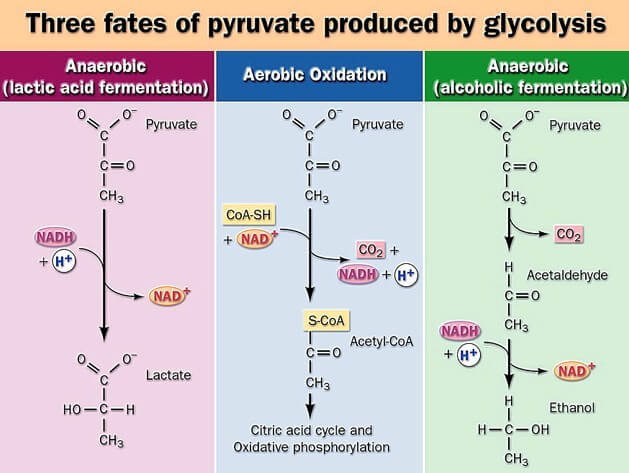Presence of is a Determinant Factor for Pyruvate to Continue
Pyruvate can enter in lactic acid fermentation and alcoholic fermentation in anaerobic condition, in aerobic condition pyruvate loss hydrogen and carbon dioxide and convert into acetyl CoA and enter into the TCA cycle, and also enter into the biosynthetic pathway. In the case of low glucose levels, pyruvate enters into gluconeogenesis.

Figure: Fate of Pyruvate. Image Source: sachabiochem0001.
The fate of pyruvate in anaerobic conditions
In anaerobic conditions pyruvate partitioned into lactic acid fermentation and alcoholic fermentation
Pyruvate work as terminal electron acceptors in lactic acid fermentation
When tissue can't be supplied by oxygen, or during exercise when less oxygen reaches muscle than their need, then pyruvate act as a terminal electron acceptor from NADH (formed during glycolysis) and converted into lactate, a process called lactic acid fermentation. RBC, retina cells, and muscles during exercise and during hypoxic condition respire by lactic acid fermentation. During lactic acid fermentation pyruvate accept an electron from NADH and reduced into lactate to restore the NAD+ for further cycling of reaction.
Pyruvate + NADH → lactate + NAD
lactate dehydrogenase
Lactate formed in the active muscles transported to the liver where it can be broken down or restore into glucose, the restored glucose from lactate transported to muscles this cycle is called a Cori cycle.
The fate of Pyruvate in alcoholic fermentation
Yeast and other microorganisms ferment glucose into ethanol, glycolytic end product pyruvate enters into alcoholic fermentation, this step takes place via a two-step reaction.
The first step is the decarboxylation of pyruvate, where pyruvate changes into acetaldehyde by losing carbon by the action of pyruvate decarboxylase enzyme in presence of TPP and Mg++.
Pyruvate → Acetaldehyde + CO2
pyruvate decarboxylase
In the second step, acetaldehyde accepts an electron from NADH (formed during glycolysis) to restore it into NAD+ for the further cycle, and converted into ethanol, by the action of alcohol dehydrogenase enzyme.
Acetaldehyde + NADH → Ethanol + NAD+
alcohol dehydrogenase
The fate of pyruvate in case of aerobic respiration
During aerobic respiration, pyruvate change into Acetyl CoA, and now enter into the TCA cycle (Krebs cycle), via oxidative decarboxylation, this reaction is catalyzed by pyruvate dehydrogenase complex made of three enzyme E1, E2, E3. E1= pyruvate dehydrogenase, E2= dihydrolipoyl transacetelase, E3= dihydrolipoyl dehydrogenase). Pyruvate dehydrogenase complex (E1, E2 & E3) requires 5 coenzymes for this reaction namely, TPP, lipoate, CoA-SH, FAD, NAD+ for catalyzing this reaction. E1 attached with TPP release CO2 from pyruvate and transfer active acetyl group to TPP, now TPP transfer acetyl group on lipoate attached with E2, and lipoate transfer acetyl group to CoA.SH forming Acetyl CoA, now E3 transfer H from reduced lipoate to FAD which transfers an electron to NAD+ forming NADH + H+. Now, this acetyl CoA can enter into TCA.
Pyruvate + E1 + E2 + E3+TPP+ lipoate+CoA-SH+ FAD+ NAD+ → Acetyl CoA+ E1+E2+E3+ TPP+ lipoate+FAD+NADH+H+
The fate of pyruvate in the biosynthetic pathway
Pyruvate can also enter into the biosynthetic pathways such as fatty acids biosynthesis and gluconeogenesis. Pyruvate changed into acetyl CoA by the action of pyruvate dehydrogenase complex this acetyl CoA also enters into the biosynthetic pathway beside TCA. Pyruvate can also enter gluconeogenesis by the action of pyruvate carboxykinase converting it into oxaloacetate which with several step reaction change into glucose.
References
- Lehninger Principle of Biochemistry by David L. Nelson and Michael M. Cox, 6th edition
- www.ncbi.nlm.nih.gov (Biochemistry, aerobic glycolysis)
- 3% – https://quizlet.com/161204842/chapter-8-alcohol-flash-cards/
- 2% – https://www.notesonzoology.com/metabolism/cori-cycle-with-diagram-biochemistry/4994
- 1% – https://www.merriam-webster.com/medical/pyruvate%20decarboxylase
- 1% – https://www.kau.edu.sa/Files/0002526/files/20209_citric_acid%5B1%5D.pdf
- 1% – https://www.healthline.com/health/how-to-get-rid-of-lactic-acid
- 1% – https://www.cram.com/flashcards/prediction-of-pyruvate-and-acetaldehyde-during-fermentation-4706168
- 1% – https://www.chemeurope.com/en/encyclopedia/Pyruvate_dehydrogenase_complex.html
- 1% – https://www.biologyonline.com/dictionary/fermentation
- 1% – https://courses.lumenlearning.com/microbiology/chapter/fermentation/
- 1% – https://chem.libretexts.org/Bookshelves/Biological_Chemistry/Supplemental_Modules_(Biological_Chemistry)/Metabolism/Catabolism/Fermentation
- 1% – https://answers.yahoo.com/question/index?qid=20081002055316AAgRaL3
bushnelltraideckon.blogspot.com
Source: https://thebiologynotes.com/fate-of-pyruvate/

0 Response to "Presence of is a Determinant Factor for Pyruvate to Continue"
Post a Comment